Integrated Logistics and Supply: A Case Study of Amazon
VerifiedAdded on 2023/06/05
|13
|3834
|431
AI Summary
This report examines Amazon's supply chain network and logistic operations with a focus on transportation, packaging, inventory management, and warehousing. Recommendations are given for improvement in these supply chain drivers, and the use of big data and integration to improve operational effectiveness at Amazon is discussed.
Contribute Materials
Your contribution can guide someone’s learning journey. Share your
documents today.

Running head: INTEGRATED LOGISTICS
Integrated logistics and supply
Name of Student:
Name of College:
Authors Note:
1
Integrated logistics and supply
Name of Student:
Name of College:
Authors Note:
1
Secure Best Marks with AI Grader
Need help grading? Try our AI Grader for instant feedback on your assignments.
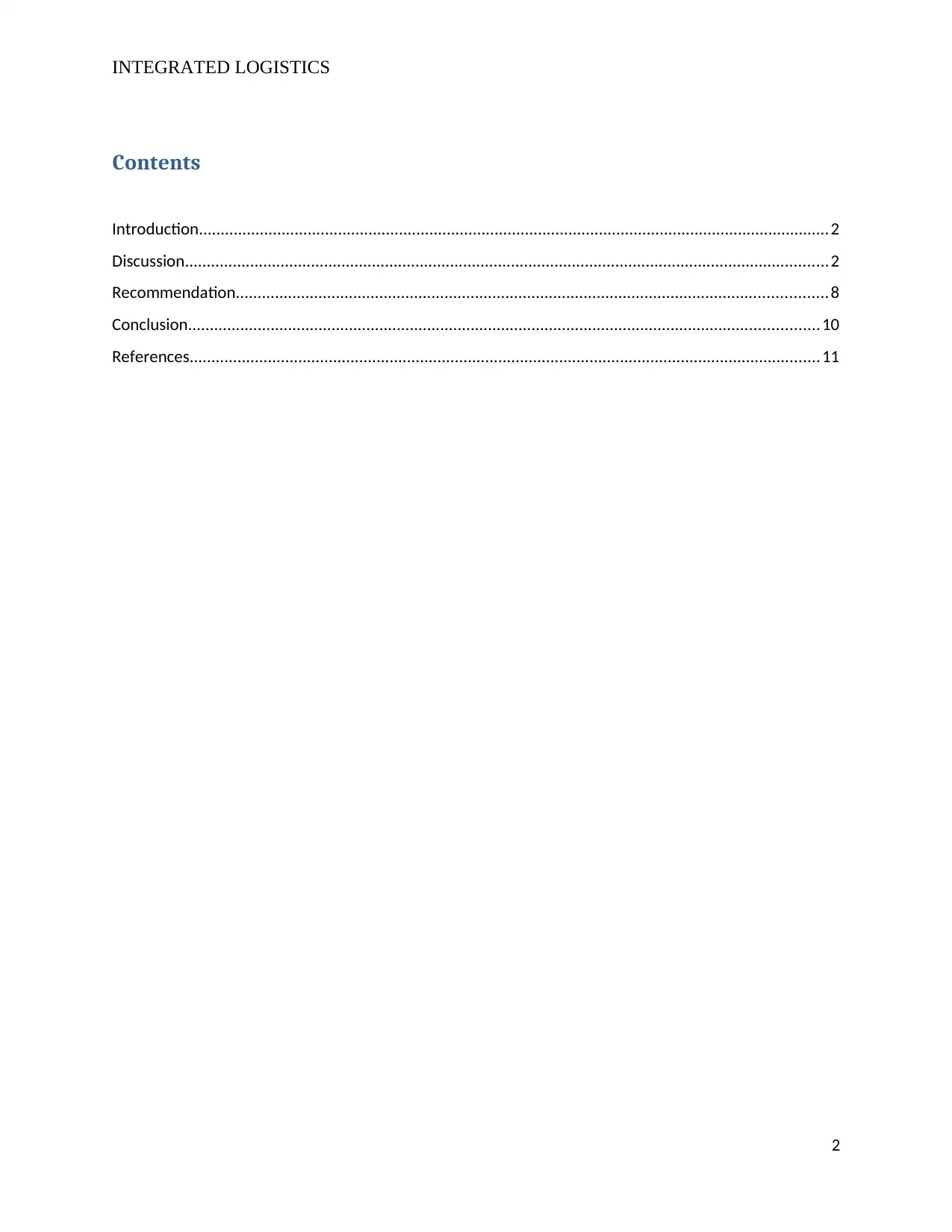
INTEGRATED LOGISTICS
Contents
Introduction.................................................................................................................................................2
Discussion....................................................................................................................................................2
Recommendation........................................................................................................................................8
Conclusion.................................................................................................................................................10
References.................................................................................................................................................11
2
Contents
Introduction.................................................................................................................................................2
Discussion....................................................................................................................................................2
Recommendation........................................................................................................................................8
Conclusion.................................................................................................................................................10
References.................................................................................................................................................11
2
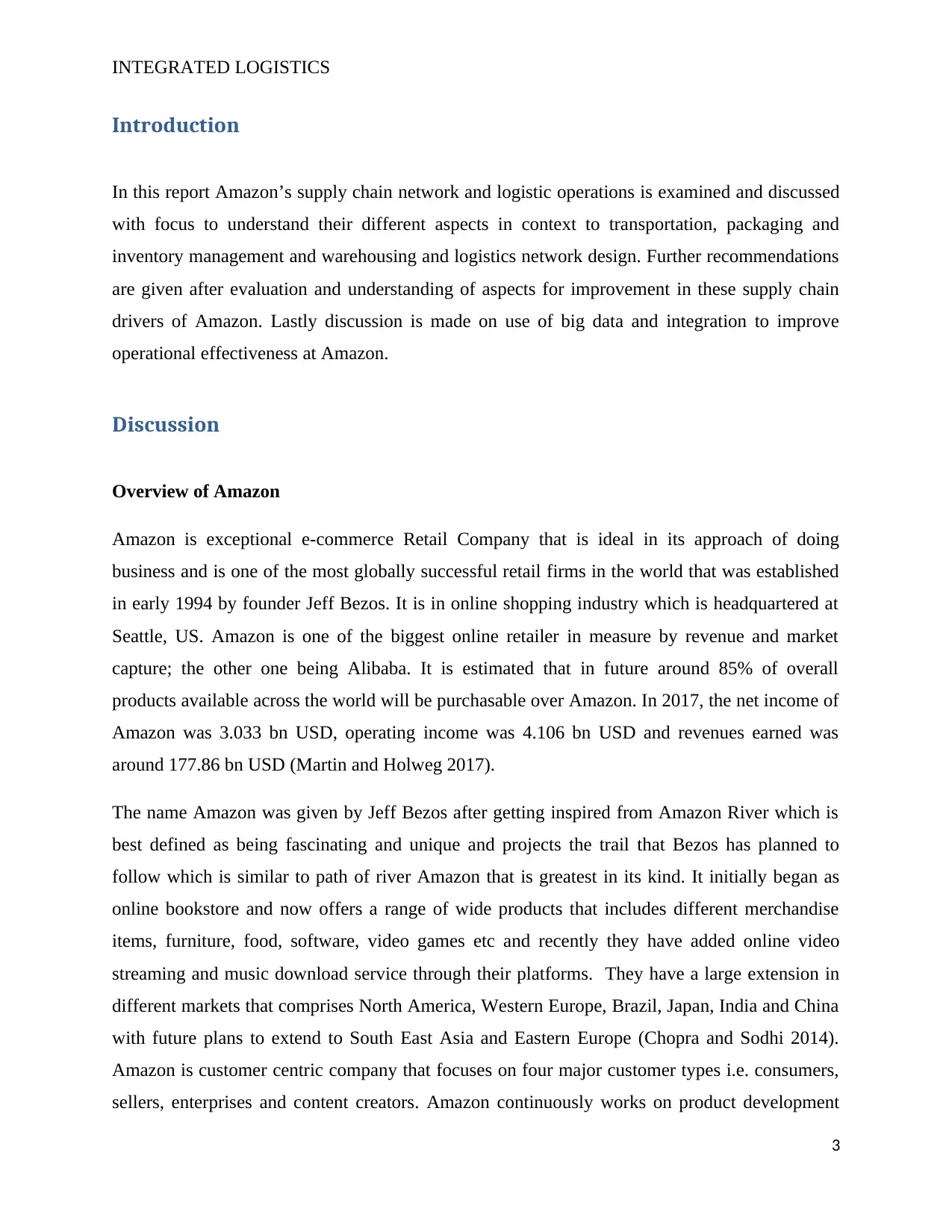
INTEGRATED LOGISTICS
Introduction
In this report Amazon’s supply chain network and logistic operations is examined and discussed
with focus to understand their different aspects in context to transportation, packaging and
inventory management and warehousing and logistics network design. Further recommendations
are given after evaluation and understanding of aspects for improvement in these supply chain
drivers of Amazon. Lastly discussion is made on use of big data and integration to improve
operational effectiveness at Amazon.
Discussion
Overview of Amazon
Amazon is exceptional e-commerce Retail Company that is ideal in its approach of doing
business and is one of the most globally successful retail firms in the world that was established
in early 1994 by founder Jeff Bezos. It is in online shopping industry which is headquartered at
Seattle, US. Amazon is one of the biggest online retailer in measure by revenue and market
capture; the other one being Alibaba. It is estimated that in future around 85% of overall
products available across the world will be purchasable over Amazon. In 2017, the net income of
Amazon was 3.033 bn USD, operating income was 4.106 bn USD and revenues earned was
around 177.86 bn USD (Martin and Holweg 2017).
The name Amazon was given by Jeff Bezos after getting inspired from Amazon River which is
best defined as being fascinating and unique and projects the trail that Bezos has planned to
follow which is similar to path of river Amazon that is greatest in its kind. It initially began as
online bookstore and now offers a range of wide products that includes different merchandise
items, furniture, food, software, video games etc and recently they have added online video
streaming and music download service through their platforms. They have a large extension in
different markets that comprises North America, Western Europe, Brazil, Japan, India and China
with future plans to extend to South East Asia and Eastern Europe (Chopra and Sodhi 2014).
Amazon is customer centric company that focuses on four major customer types i.e. consumers,
sellers, enterprises and content creators. Amazon continuously works on product development
3
Introduction
In this report Amazon’s supply chain network and logistic operations is examined and discussed
with focus to understand their different aspects in context to transportation, packaging and
inventory management and warehousing and logistics network design. Further recommendations
are given after evaluation and understanding of aspects for improvement in these supply chain
drivers of Amazon. Lastly discussion is made on use of big data and integration to improve
operational effectiveness at Amazon.
Discussion
Overview of Amazon
Amazon is exceptional e-commerce Retail Company that is ideal in its approach of doing
business and is one of the most globally successful retail firms in the world that was established
in early 1994 by founder Jeff Bezos. It is in online shopping industry which is headquartered at
Seattle, US. Amazon is one of the biggest online retailer in measure by revenue and market
capture; the other one being Alibaba. It is estimated that in future around 85% of overall
products available across the world will be purchasable over Amazon. In 2017, the net income of
Amazon was 3.033 bn USD, operating income was 4.106 bn USD and revenues earned was
around 177.86 bn USD (Martin and Holweg 2017).
The name Amazon was given by Jeff Bezos after getting inspired from Amazon River which is
best defined as being fascinating and unique and projects the trail that Bezos has planned to
follow which is similar to path of river Amazon that is greatest in its kind. It initially began as
online bookstore and now offers a range of wide products that includes different merchandise
items, furniture, food, software, video games etc and recently they have added online video
streaming and music download service through their platforms. They have a large extension in
different markets that comprises North America, Western Europe, Brazil, Japan, India and China
with future plans to extend to South East Asia and Eastern Europe (Chopra and Sodhi 2014).
Amazon is customer centric company that focuses on four major customer types i.e. consumers,
sellers, enterprises and content creators. Amazon continuously works on product development
3
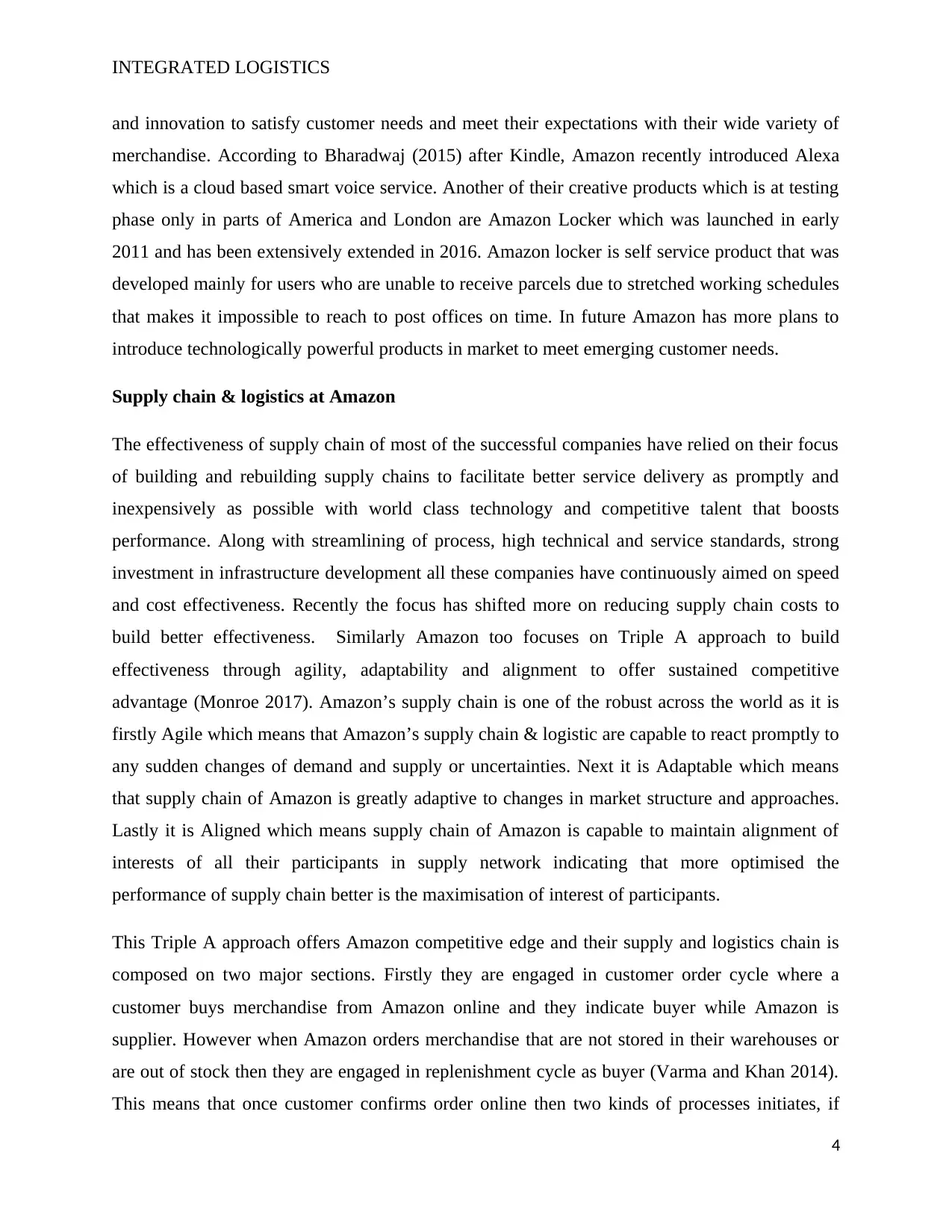
INTEGRATED LOGISTICS
and innovation to satisfy customer needs and meet their expectations with their wide variety of
merchandise. According to Bharadwaj (2015) after Kindle, Amazon recently introduced Alexa
which is a cloud based smart voice service. Another of their creative products which is at testing
phase only in parts of America and London are Amazon Locker which was launched in early
2011 and has been extensively extended in 2016. Amazon locker is self service product that was
developed mainly for users who are unable to receive parcels due to stretched working schedules
that makes it impossible to reach to post offices on time. In future Amazon has more plans to
introduce technologically powerful products in market to meet emerging customer needs.
Supply chain & logistics at Amazon
The effectiveness of supply chain of most of the successful companies have relied on their focus
of building and rebuilding supply chains to facilitate better service delivery as promptly and
inexpensively as possible with world class technology and competitive talent that boosts
performance. Along with streamlining of process, high technical and service standards, strong
investment in infrastructure development all these companies have continuously aimed on speed
and cost effectiveness. Recently the focus has shifted more on reducing supply chain costs to
build better effectiveness. Similarly Amazon too focuses on Triple A approach to build
effectiveness through agility, adaptability and alignment to offer sustained competitive
advantage (Monroe 2017). Amazon’s supply chain is one of the robust across the world as it is
firstly Agile which means that Amazon’s supply chain & logistic are capable to react promptly to
any sudden changes of demand and supply or uncertainties. Next it is Adaptable which means
that supply chain of Amazon is greatly adaptive to changes in market structure and approaches.
Lastly it is Aligned which means supply chain of Amazon is capable to maintain alignment of
interests of all their participants in supply network indicating that more optimised the
performance of supply chain better is the maximisation of interest of participants.
This Triple A approach offers Amazon competitive edge and their supply and logistics chain is
composed on two major sections. Firstly they are engaged in customer order cycle where a
customer buys merchandise from Amazon online and they indicate buyer while Amazon is
supplier. However when Amazon orders merchandise that are not stored in their warehouses or
are out of stock then they are engaged in replenishment cycle as buyer (Varma and Khan 2014).
This means that once customer confirms order online then two kinds of processes initiates, if
4
and innovation to satisfy customer needs and meet their expectations with their wide variety of
merchandise. According to Bharadwaj (2015) after Kindle, Amazon recently introduced Alexa
which is a cloud based smart voice service. Another of their creative products which is at testing
phase only in parts of America and London are Amazon Locker which was launched in early
2011 and has been extensively extended in 2016. Amazon locker is self service product that was
developed mainly for users who are unable to receive parcels due to stretched working schedules
that makes it impossible to reach to post offices on time. In future Amazon has more plans to
introduce technologically powerful products in market to meet emerging customer needs.
Supply chain & logistics at Amazon
The effectiveness of supply chain of most of the successful companies have relied on their focus
of building and rebuilding supply chains to facilitate better service delivery as promptly and
inexpensively as possible with world class technology and competitive talent that boosts
performance. Along with streamlining of process, high technical and service standards, strong
investment in infrastructure development all these companies have continuously aimed on speed
and cost effectiveness. Recently the focus has shifted more on reducing supply chain costs to
build better effectiveness. Similarly Amazon too focuses on Triple A approach to build
effectiveness through agility, adaptability and alignment to offer sustained competitive
advantage (Monroe 2017). Amazon’s supply chain is one of the robust across the world as it is
firstly Agile which means that Amazon’s supply chain & logistic are capable to react promptly to
any sudden changes of demand and supply or uncertainties. Next it is Adaptable which means
that supply chain of Amazon is greatly adaptive to changes in market structure and approaches.
Lastly it is Aligned which means supply chain of Amazon is capable to maintain alignment of
interests of all their participants in supply network indicating that more optimised the
performance of supply chain better is the maximisation of interest of participants.
This Triple A approach offers Amazon competitive edge and their supply and logistics chain is
composed on two major sections. Firstly they are engaged in customer order cycle where a
customer buys merchandise from Amazon online and they indicate buyer while Amazon is
supplier. However when Amazon orders merchandise that are not stored in their warehouses or
are out of stock then they are engaged in replenishment cycle as buyer (Varma and Khan 2014).
This means that once customer confirms order online then two kinds of processes initiates, if
4
Secure Best Marks with AI Grader
Need help grading? Try our AI Grader for instant feedback on your assignments.
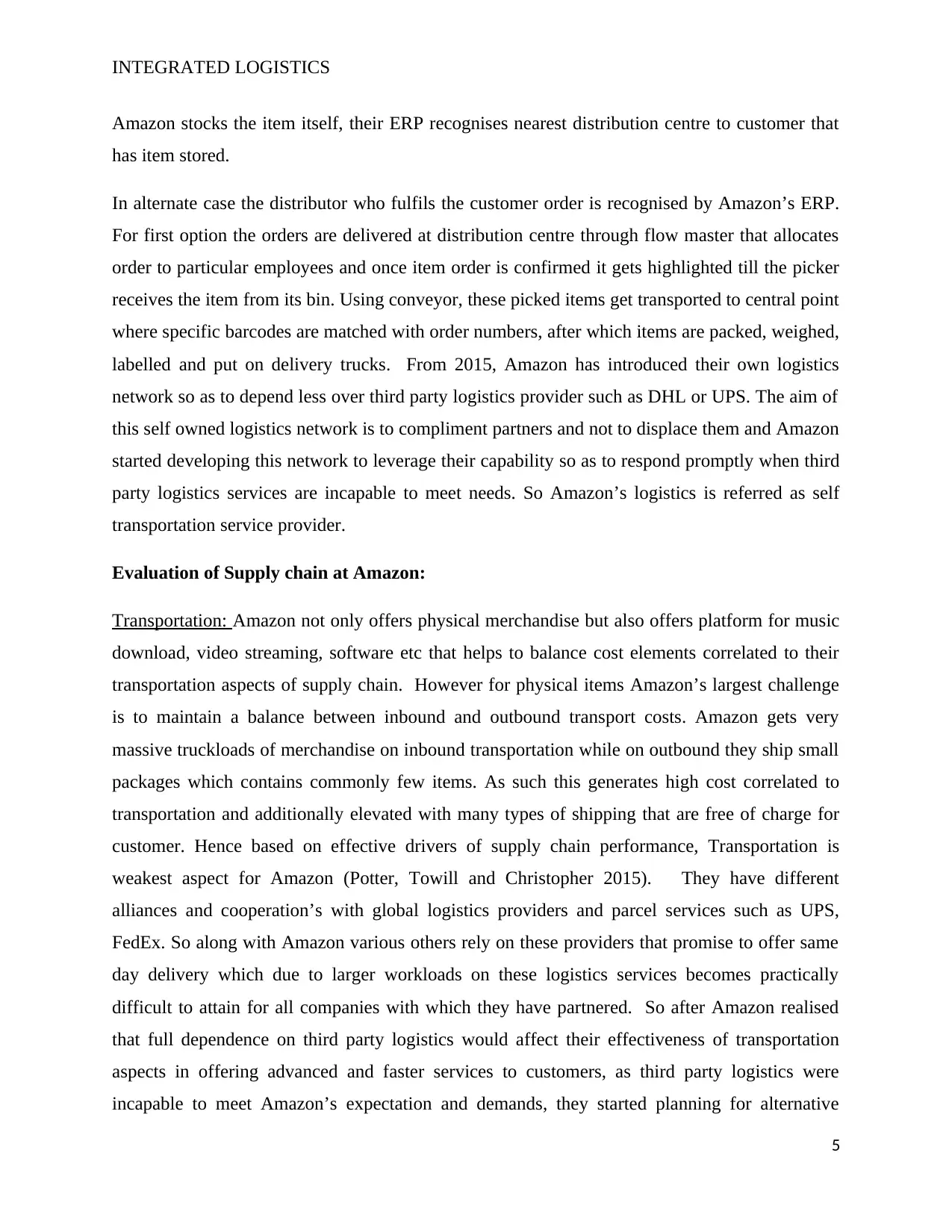
INTEGRATED LOGISTICS
Amazon stocks the item itself, their ERP recognises nearest distribution centre to customer that
has item stored.
In alternate case the distributor who fulfils the customer order is recognised by Amazon’s ERP.
For first option the orders are delivered at distribution centre through flow master that allocates
order to particular employees and once item order is confirmed it gets highlighted till the picker
receives the item from its bin. Using conveyor, these picked items get transported to central point
where specific barcodes are matched with order numbers, after which items are packed, weighed,
labelled and put on delivery trucks. From 2015, Amazon has introduced their own logistics
network so as to depend less over third party logistics provider such as DHL or UPS. The aim of
this self owned logistics network is to compliment partners and not to displace them and Amazon
started developing this network to leverage their capability so as to respond promptly when third
party logistics services are incapable to meet needs. So Amazon’s logistics is referred as self
transportation service provider.
Evaluation of Supply chain at Amazon:
Transportation: Amazon not only offers physical merchandise but also offers platform for music
download, video streaming, software etc that helps to balance cost elements correlated to their
transportation aspects of supply chain. However for physical items Amazon’s largest challenge
is to maintain a balance between inbound and outbound transport costs. Amazon gets very
massive truckloads of merchandise on inbound transportation while on outbound they ship small
packages which contains commonly few items. As such this generates high cost correlated to
transportation and additionally elevated with many types of shipping that are free of charge for
customer. Hence based on effective drivers of supply chain performance, Transportation is
weakest aspect for Amazon (Potter, Towill and Christopher 2015). They have different
alliances and cooperation’s with global logistics providers and parcel services such as UPS,
FedEx. So along with Amazon various others rely on these providers that promise to offer same
day delivery which due to larger workloads on these logistics services becomes practically
difficult to attain for all companies with which they have partnered. So after Amazon realised
that full dependence on third party logistics would affect their effectiveness of transportation
aspects in offering advanced and faster services to customers, as third party logistics were
incapable to meet Amazon’s expectation and demands, they started planning for alternative
5
Amazon stocks the item itself, their ERP recognises nearest distribution centre to customer that
has item stored.
In alternate case the distributor who fulfils the customer order is recognised by Amazon’s ERP.
For first option the orders are delivered at distribution centre through flow master that allocates
order to particular employees and once item order is confirmed it gets highlighted till the picker
receives the item from its bin. Using conveyor, these picked items get transported to central point
where specific barcodes are matched with order numbers, after which items are packed, weighed,
labelled and put on delivery trucks. From 2015, Amazon has introduced their own logistics
network so as to depend less over third party logistics provider such as DHL or UPS. The aim of
this self owned logistics network is to compliment partners and not to displace them and Amazon
started developing this network to leverage their capability so as to respond promptly when third
party logistics services are incapable to meet needs. So Amazon’s logistics is referred as self
transportation service provider.
Evaluation of Supply chain at Amazon:
Transportation: Amazon not only offers physical merchandise but also offers platform for music
download, video streaming, software etc that helps to balance cost elements correlated to their
transportation aspects of supply chain. However for physical items Amazon’s largest challenge
is to maintain a balance between inbound and outbound transport costs. Amazon gets very
massive truckloads of merchandise on inbound transportation while on outbound they ship small
packages which contains commonly few items. As such this generates high cost correlated to
transportation and additionally elevated with many types of shipping that are free of charge for
customer. Hence based on effective drivers of supply chain performance, Transportation is
weakest aspect for Amazon (Potter, Towill and Christopher 2015). They have different
alliances and cooperation’s with global logistics providers and parcel services such as UPS,
FedEx. So along with Amazon various others rely on these providers that promise to offer same
day delivery which due to larger workloads on these logistics services becomes practically
difficult to attain for all companies with which they have partnered. So after Amazon realised
that full dependence on third party logistics would affect their effectiveness of transportation
aspects in offering advanced and faster services to customers, as third party logistics were
incapable to meet Amazon’s expectation and demands, they started planning for alternative
5
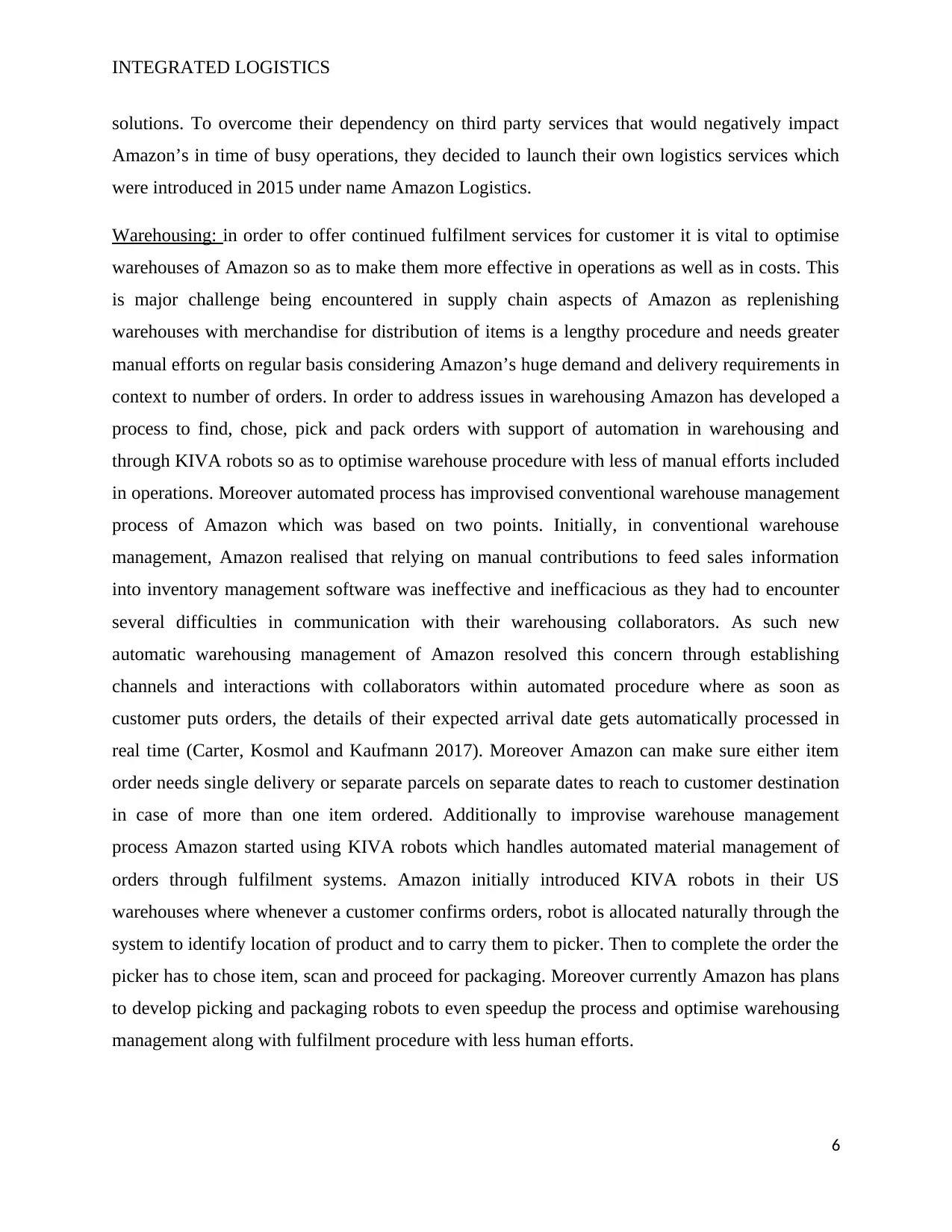
INTEGRATED LOGISTICS
solutions. To overcome their dependency on third party services that would negatively impact
Amazon’s in time of busy operations, they decided to launch their own logistics services which
were introduced in 2015 under name Amazon Logistics.
Warehousing: in order to offer continued fulfilment services for customer it is vital to optimise
warehouses of Amazon so as to make them more effective in operations as well as in costs. This
is major challenge being encountered in supply chain aspects of Amazon as replenishing
warehouses with merchandise for distribution of items is a lengthy procedure and needs greater
manual efforts on regular basis considering Amazon’s huge demand and delivery requirements in
context to number of orders. In order to address issues in warehousing Amazon has developed a
process to find, chose, pick and pack orders with support of automation in warehousing and
through KIVA robots so as to optimise warehouse procedure with less of manual efforts included
in operations. Moreover automated process has improvised conventional warehouse management
process of Amazon which was based on two points. Initially, in conventional warehouse
management, Amazon realised that relying on manual contributions to feed sales information
into inventory management software was ineffective and inefficacious as they had to encounter
several difficulties in communication with their warehousing collaborators. As such new
automatic warehousing management of Amazon resolved this concern through establishing
channels and interactions with collaborators within automated procedure where as soon as
customer puts orders, the details of their expected arrival date gets automatically processed in
real time (Carter, Kosmol and Kaufmann 2017). Moreover Amazon can make sure either item
order needs single delivery or separate parcels on separate dates to reach to customer destination
in case of more than one item ordered. Additionally to improvise warehouse management
process Amazon started using KIVA robots which handles automated material management of
orders through fulfilment systems. Amazon initially introduced KIVA robots in their US
warehouses where whenever a customer confirms orders, robot is allocated naturally through the
system to identify location of product and to carry them to picker. Then to complete the order the
picker has to chose item, scan and proceed for packaging. Moreover currently Amazon has plans
to develop picking and packaging robots to even speedup the process and optimise warehousing
management along with fulfilment procedure with less human efforts.
6
solutions. To overcome their dependency on third party services that would negatively impact
Amazon’s in time of busy operations, they decided to launch their own logistics services which
were introduced in 2015 under name Amazon Logistics.
Warehousing: in order to offer continued fulfilment services for customer it is vital to optimise
warehouses of Amazon so as to make them more effective in operations as well as in costs. This
is major challenge being encountered in supply chain aspects of Amazon as replenishing
warehouses with merchandise for distribution of items is a lengthy procedure and needs greater
manual efforts on regular basis considering Amazon’s huge demand and delivery requirements in
context to number of orders. In order to address issues in warehousing Amazon has developed a
process to find, chose, pick and pack orders with support of automation in warehousing and
through KIVA robots so as to optimise warehouse procedure with less of manual efforts included
in operations. Moreover automated process has improvised conventional warehouse management
process of Amazon which was based on two points. Initially, in conventional warehouse
management, Amazon realised that relying on manual contributions to feed sales information
into inventory management software was ineffective and inefficacious as they had to encounter
several difficulties in communication with their warehousing collaborators. As such new
automatic warehousing management of Amazon resolved this concern through establishing
channels and interactions with collaborators within automated procedure where as soon as
customer puts orders, the details of their expected arrival date gets automatically processed in
real time (Carter, Kosmol and Kaufmann 2017). Moreover Amazon can make sure either item
order needs single delivery or separate parcels on separate dates to reach to customer destination
in case of more than one item ordered. Additionally to improvise warehouse management
process Amazon started using KIVA robots which handles automated material management of
orders through fulfilment systems. Amazon initially introduced KIVA robots in their US
warehouses where whenever a customer confirms orders, robot is allocated naturally through the
system to identify location of product and to carry them to picker. Then to complete the order the
picker has to chose item, scan and proceed for packaging. Moreover currently Amazon has plans
to develop picking and packaging robots to even speedup the process and optimise warehousing
management along with fulfilment procedure with less human efforts.
6
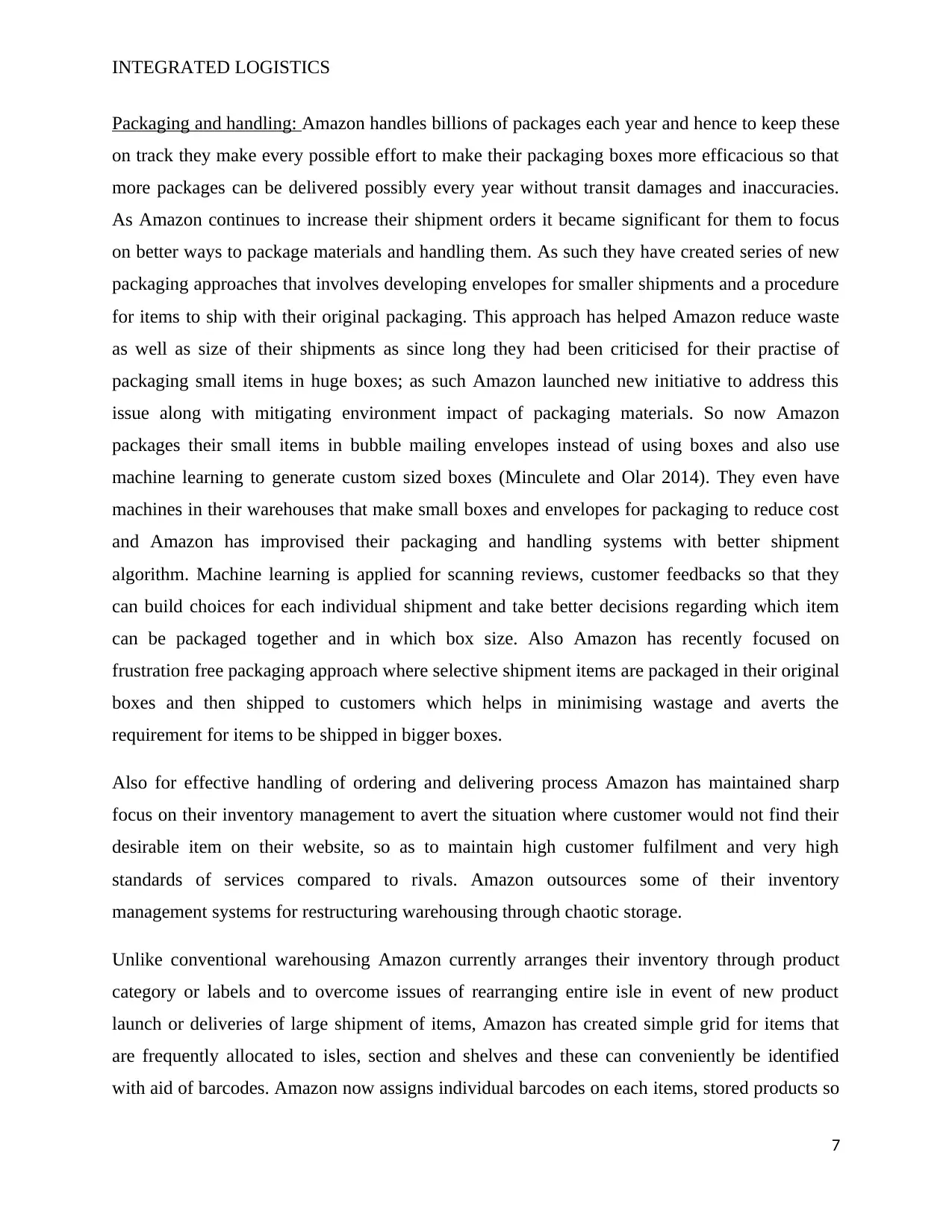
INTEGRATED LOGISTICS
Packaging and handling: Amazon handles billions of packages each year and hence to keep these
on track they make every possible effort to make their packaging boxes more efficacious so that
more packages can be delivered possibly every year without transit damages and inaccuracies.
As Amazon continues to increase their shipment orders it became significant for them to focus
on better ways to package materials and handling them. As such they have created series of new
packaging approaches that involves developing envelopes for smaller shipments and a procedure
for items to ship with their original packaging. This approach has helped Amazon reduce waste
as well as size of their shipments as since long they had been criticised for their practise of
packaging small items in huge boxes; as such Amazon launched new initiative to address this
issue along with mitigating environment impact of packaging materials. So now Amazon
packages their small items in bubble mailing envelopes instead of using boxes and also use
machine learning to generate custom sized boxes (Minculete and Olar 2014). They even have
machines in their warehouses that make small boxes and envelopes for packaging to reduce cost
and Amazon has improvised their packaging and handling systems with better shipment
algorithm. Machine learning is applied for scanning reviews, customer feedbacks so that they
can build choices for each individual shipment and take better decisions regarding which item
can be packaged together and in which box size. Also Amazon has recently focused on
frustration free packaging approach where selective shipment items are packaged in their original
boxes and then shipped to customers which helps in minimising wastage and averts the
requirement for items to be shipped in bigger boxes.
Also for effective handling of ordering and delivering process Amazon has maintained sharp
focus on their inventory management to avert the situation where customer would not find their
desirable item on their website, so as to maintain high customer fulfilment and very high
standards of services compared to rivals. Amazon outsources some of their inventory
management systems for restructuring warehousing through chaotic storage.
Unlike conventional warehousing Amazon currently arranges their inventory through product
category or labels and to overcome issues of rearranging entire isle in event of new product
launch or deliveries of large shipment of items, Amazon has created simple grid for items that
are frequently allocated to isles, section and shelves and these can conveniently be identified
with aid of barcodes. Amazon now assigns individual barcodes on each items, stored products so
7
Packaging and handling: Amazon handles billions of packages each year and hence to keep these
on track they make every possible effort to make their packaging boxes more efficacious so that
more packages can be delivered possibly every year without transit damages and inaccuracies.
As Amazon continues to increase their shipment orders it became significant for them to focus
on better ways to package materials and handling them. As such they have created series of new
packaging approaches that involves developing envelopes for smaller shipments and a procedure
for items to ship with their original packaging. This approach has helped Amazon reduce waste
as well as size of their shipments as since long they had been criticised for their practise of
packaging small items in huge boxes; as such Amazon launched new initiative to address this
issue along with mitigating environment impact of packaging materials. So now Amazon
packages their small items in bubble mailing envelopes instead of using boxes and also use
machine learning to generate custom sized boxes (Minculete and Olar 2014). They even have
machines in their warehouses that make small boxes and envelopes for packaging to reduce cost
and Amazon has improvised their packaging and handling systems with better shipment
algorithm. Machine learning is applied for scanning reviews, customer feedbacks so that they
can build choices for each individual shipment and take better decisions regarding which item
can be packaged together and in which box size. Also Amazon has recently focused on
frustration free packaging approach where selective shipment items are packaged in their original
boxes and then shipped to customers which helps in minimising wastage and averts the
requirement for items to be shipped in bigger boxes.
Also for effective handling of ordering and delivering process Amazon has maintained sharp
focus on their inventory management to avert the situation where customer would not find their
desirable item on their website, so as to maintain high customer fulfilment and very high
standards of services compared to rivals. Amazon outsources some of their inventory
management systems for restructuring warehousing through chaotic storage.
Unlike conventional warehousing Amazon currently arranges their inventory through product
category or labels and to overcome issues of rearranging entire isle in event of new product
launch or deliveries of large shipment of items, Amazon has created simple grid for items that
are frequently allocated to isles, section and shelves and these can conveniently be identified
with aid of barcodes. Amazon now assigns individual barcodes on each items, stored products so
7
Paraphrase This Document
Need a fresh take? Get an instant paraphrase of this document with our AI Paraphraser

INTEGRATED LOGISTICS
that these can be easily located and at greater speed. Additionally, Amazon has started
registration system with their barcodes which are capable of updating item availability on real
time basis. This means that once a shipment is packaged and shipped to customer and scanned by
employees the available quantity of items gets lowered automatically (Monroe 2017). Further for
high demand items Amazon currently is working on reorder implementation points which would
consist of automatic re-ordering systems where once inventory drops below a specified level,
then automatically order for re-stocking would be generated without human involvement.
Network design
Fig: Network design of logistics at Amazon
Source: research gate (2018)
Amazon uses a systematic network design to ensure flow of activities and their coordination with
logistics operations as illustrated in the above figure. The network design of Amazon is a simple
process that is applied in their supply chain. The demand forecast information and service
requirement policies are put into the Inventory, Planning and Control system of Amazon which
ascertains order quantity for each item that is to reach at individual fulfilment centre (FC).
Orders are put through automatic systems or retail managers work stations, where these orders
are accumulated into Purchase order by Procurement execution systems and then sent to vendors
8
that these can be easily located and at greater speed. Additionally, Amazon has started
registration system with their barcodes which are capable of updating item availability on real
time basis. This means that once a shipment is packaged and shipped to customer and scanned by
employees the available quantity of items gets lowered automatically (Monroe 2017). Further for
high demand items Amazon currently is working on reorder implementation points which would
consist of automatic re-ordering systems where once inventory drops below a specified level,
then automatically order for re-stocking would be generated without human involvement.
Network design
Fig: Network design of logistics at Amazon
Source: research gate (2018)
Amazon uses a systematic network design to ensure flow of activities and their coordination with
logistics operations as illustrated in the above figure. The network design of Amazon is a simple
process that is applied in their supply chain. The demand forecast information and service
requirement policies are put into the Inventory, Planning and Control system of Amazon which
ascertains order quantity for each item that is to reach at individual fulfilment centre (FC).
Orders are put through automatic systems or retail managers work stations, where these orders
are accumulated into Purchase order by Procurement execution systems and then sent to vendors
8
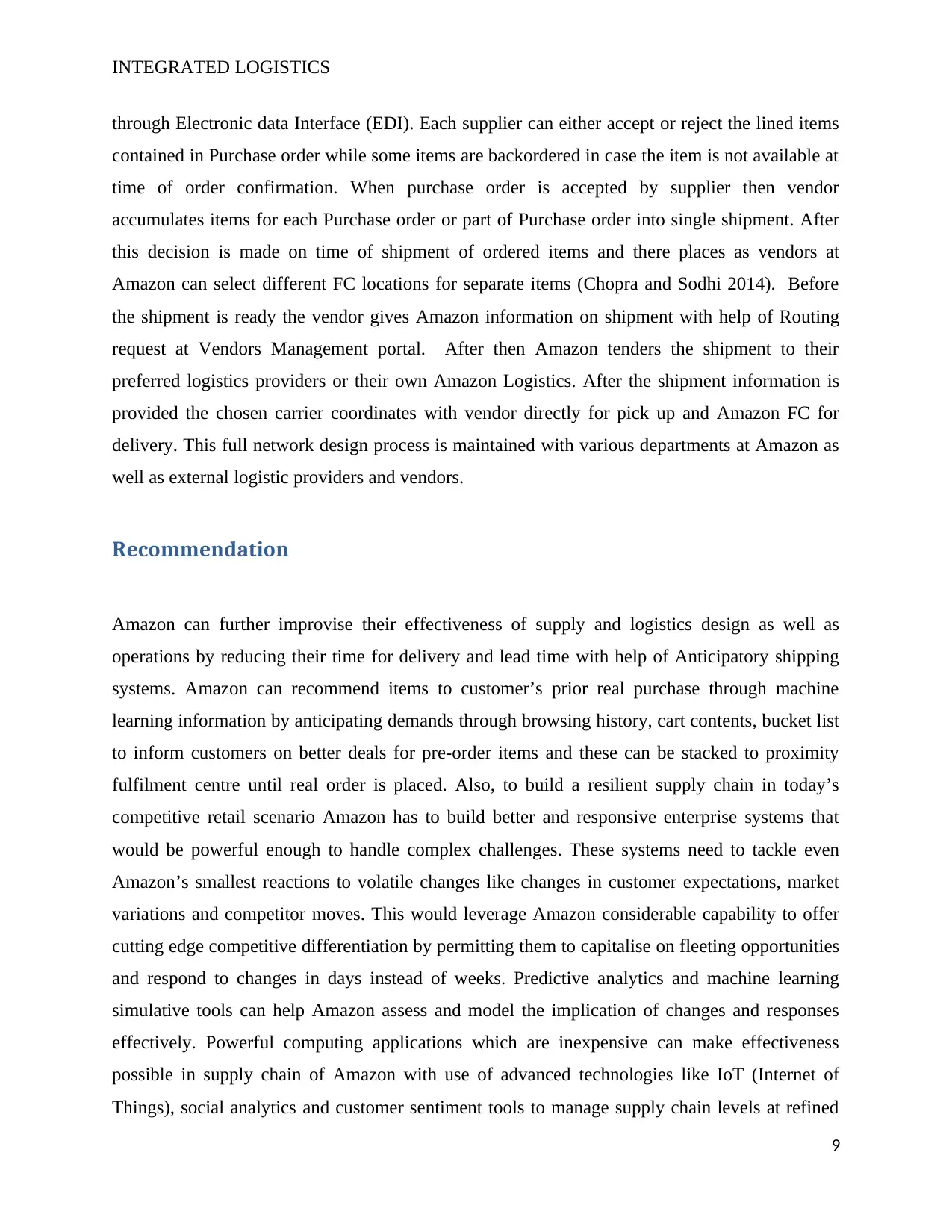
INTEGRATED LOGISTICS
through Electronic data Interface (EDI). Each supplier can either accept or reject the lined items
contained in Purchase order while some items are backordered in case the item is not available at
time of order confirmation. When purchase order is accepted by supplier then vendor
accumulates items for each Purchase order or part of Purchase order into single shipment. After
this decision is made on time of shipment of ordered items and there places as vendors at
Amazon can select different FC locations for separate items (Chopra and Sodhi 2014). Before
the shipment is ready the vendor gives Amazon information on shipment with help of Routing
request at Vendors Management portal. After then Amazon tenders the shipment to their
preferred logistics providers or their own Amazon Logistics. After the shipment information is
provided the chosen carrier coordinates with vendor directly for pick up and Amazon FC for
delivery. This full network design process is maintained with various departments at Amazon as
well as external logistic providers and vendors.
Recommendation
Amazon can further improvise their effectiveness of supply and logistics design as well as
operations by reducing their time for delivery and lead time with help of Anticipatory shipping
systems. Amazon can recommend items to customer’s prior real purchase through machine
learning information by anticipating demands through browsing history, cart contents, bucket list
to inform customers on better deals for pre-order items and these can be stacked to proximity
fulfilment centre until real order is placed. Also, to build a resilient supply chain in today’s
competitive retail scenario Amazon has to build better and responsive enterprise systems that
would be powerful enough to handle complex challenges. These systems need to tackle even
Amazon’s smallest reactions to volatile changes like changes in customer expectations, market
variations and competitor moves. This would leverage Amazon considerable capability to offer
cutting edge competitive differentiation by permitting them to capitalise on fleeting opportunities
and respond to changes in days instead of weeks. Predictive analytics and machine learning
simulative tools can help Amazon assess and model the implication of changes and responses
effectively. Powerful computing applications which are inexpensive can make effectiveness
possible in supply chain of Amazon with use of advanced technologies like IoT (Internet of
Things), social analytics and customer sentiment tools to manage supply chain levels at refined
9
through Electronic data Interface (EDI). Each supplier can either accept or reject the lined items
contained in Purchase order while some items are backordered in case the item is not available at
time of order confirmation. When purchase order is accepted by supplier then vendor
accumulates items for each Purchase order or part of Purchase order into single shipment. After
this decision is made on time of shipment of ordered items and there places as vendors at
Amazon can select different FC locations for separate items (Chopra and Sodhi 2014). Before
the shipment is ready the vendor gives Amazon information on shipment with help of Routing
request at Vendors Management portal. After then Amazon tenders the shipment to their
preferred logistics providers or their own Amazon Logistics. After the shipment information is
provided the chosen carrier coordinates with vendor directly for pick up and Amazon FC for
delivery. This full network design process is maintained with various departments at Amazon as
well as external logistic providers and vendors.
Recommendation
Amazon can further improvise their effectiveness of supply and logistics design as well as
operations by reducing their time for delivery and lead time with help of Anticipatory shipping
systems. Amazon can recommend items to customer’s prior real purchase through machine
learning information by anticipating demands through browsing history, cart contents, bucket list
to inform customers on better deals for pre-order items and these can be stacked to proximity
fulfilment centre until real order is placed. Also, to build a resilient supply chain in today’s
competitive retail scenario Amazon has to build better and responsive enterprise systems that
would be powerful enough to handle complex challenges. These systems need to tackle even
Amazon’s smallest reactions to volatile changes like changes in customer expectations, market
variations and competitor moves. This would leverage Amazon considerable capability to offer
cutting edge competitive differentiation by permitting them to capitalise on fleeting opportunities
and respond to changes in days instead of weeks. Predictive analytics and machine learning
simulative tools can help Amazon assess and model the implication of changes and responses
effectively. Powerful computing applications which are inexpensive can make effectiveness
possible in supply chain of Amazon with use of advanced technologies like IoT (Internet of
Things), social analytics and customer sentiment tools to manage supply chain levels at refined
9
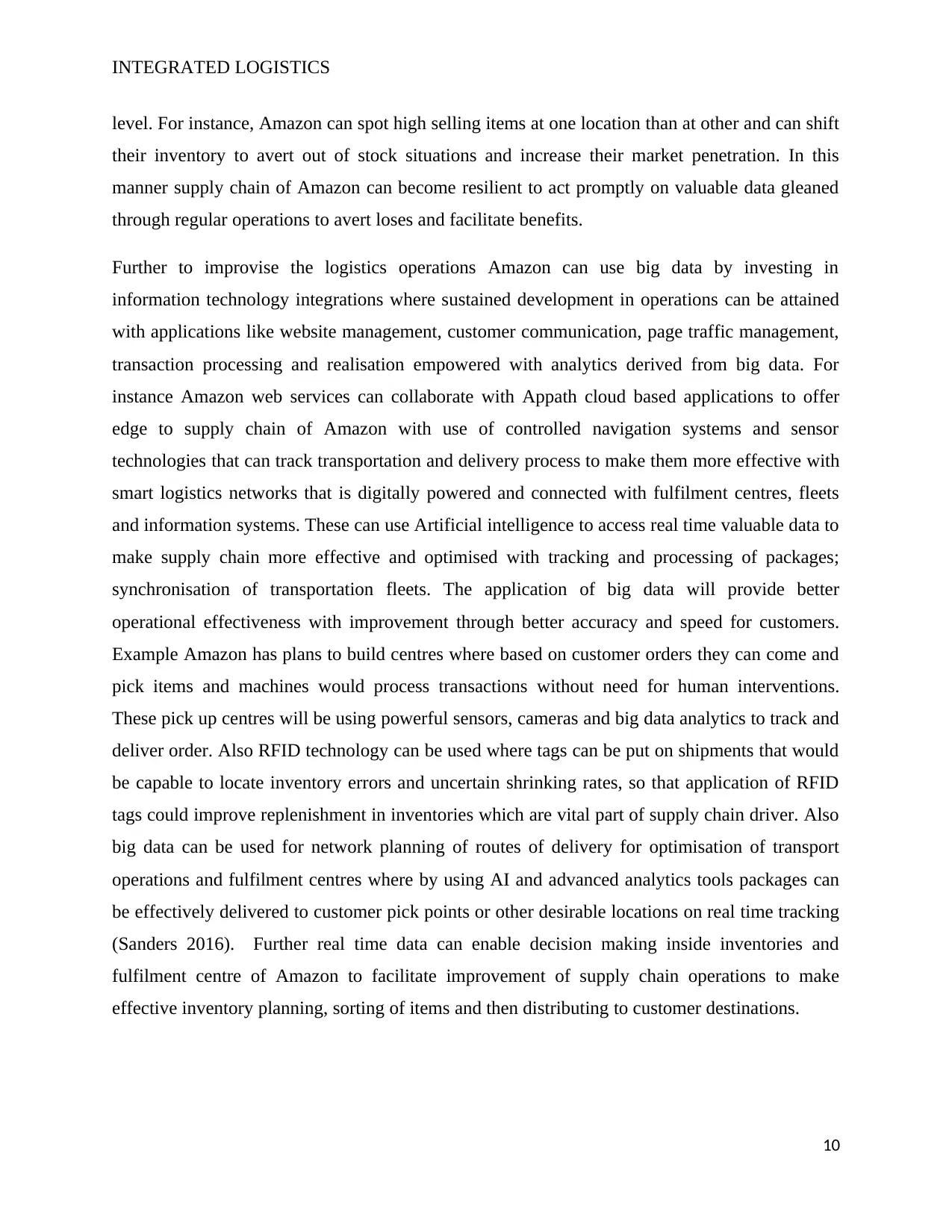
INTEGRATED LOGISTICS
level. For instance, Amazon can spot high selling items at one location than at other and can shift
their inventory to avert out of stock situations and increase their market penetration. In this
manner supply chain of Amazon can become resilient to act promptly on valuable data gleaned
through regular operations to avert loses and facilitate benefits.
Further to improvise the logistics operations Amazon can use big data by investing in
information technology integrations where sustained development in operations can be attained
with applications like website management, customer communication, page traffic management,
transaction processing and realisation empowered with analytics derived from big data. For
instance Amazon web services can collaborate with Appath cloud based applications to offer
edge to supply chain of Amazon with use of controlled navigation systems and sensor
technologies that can track transportation and delivery process to make them more effective with
smart logistics networks that is digitally powered and connected with fulfilment centres, fleets
and information systems. These can use Artificial intelligence to access real time valuable data to
make supply chain more effective and optimised with tracking and processing of packages;
synchronisation of transportation fleets. The application of big data will provide better
operational effectiveness with improvement through better accuracy and speed for customers.
Example Amazon has plans to build centres where based on customer orders they can come and
pick items and machines would process transactions without need for human interventions.
These pick up centres will be using powerful sensors, cameras and big data analytics to track and
deliver order. Also RFID technology can be used where tags can be put on shipments that would
be capable to locate inventory errors and uncertain shrinking rates, so that application of RFID
tags could improve replenishment in inventories which are vital part of supply chain driver. Also
big data can be used for network planning of routes of delivery for optimisation of transport
operations and fulfilment centres where by using AI and advanced analytics tools packages can
be effectively delivered to customer pick points or other desirable locations on real time tracking
(Sanders 2016). Further real time data can enable decision making inside inventories and
fulfilment centre of Amazon to facilitate improvement of supply chain operations to make
effective inventory planning, sorting of items and then distributing to customer destinations.
10
level. For instance, Amazon can spot high selling items at one location than at other and can shift
their inventory to avert out of stock situations and increase their market penetration. In this
manner supply chain of Amazon can become resilient to act promptly on valuable data gleaned
through regular operations to avert loses and facilitate benefits.
Further to improvise the logistics operations Amazon can use big data by investing in
information technology integrations where sustained development in operations can be attained
with applications like website management, customer communication, page traffic management,
transaction processing and realisation empowered with analytics derived from big data. For
instance Amazon web services can collaborate with Appath cloud based applications to offer
edge to supply chain of Amazon with use of controlled navigation systems and sensor
technologies that can track transportation and delivery process to make them more effective with
smart logistics networks that is digitally powered and connected with fulfilment centres, fleets
and information systems. These can use Artificial intelligence to access real time valuable data to
make supply chain more effective and optimised with tracking and processing of packages;
synchronisation of transportation fleets. The application of big data will provide better
operational effectiveness with improvement through better accuracy and speed for customers.
Example Amazon has plans to build centres where based on customer orders they can come and
pick items and machines would process transactions without need for human interventions.
These pick up centres will be using powerful sensors, cameras and big data analytics to track and
deliver order. Also RFID technology can be used where tags can be put on shipments that would
be capable to locate inventory errors and uncertain shrinking rates, so that application of RFID
tags could improve replenishment in inventories which are vital part of supply chain driver. Also
big data can be used for network planning of routes of delivery for optimisation of transport
operations and fulfilment centres where by using AI and advanced analytics tools packages can
be effectively delivered to customer pick points or other desirable locations on real time tracking
(Sanders 2016). Further real time data can enable decision making inside inventories and
fulfilment centre of Amazon to facilitate improvement of supply chain operations to make
effective inventory planning, sorting of items and then distributing to customer destinations.
10
Secure Best Marks with AI Grader
Need help grading? Try our AI Grader for instant feedback on your assignments.
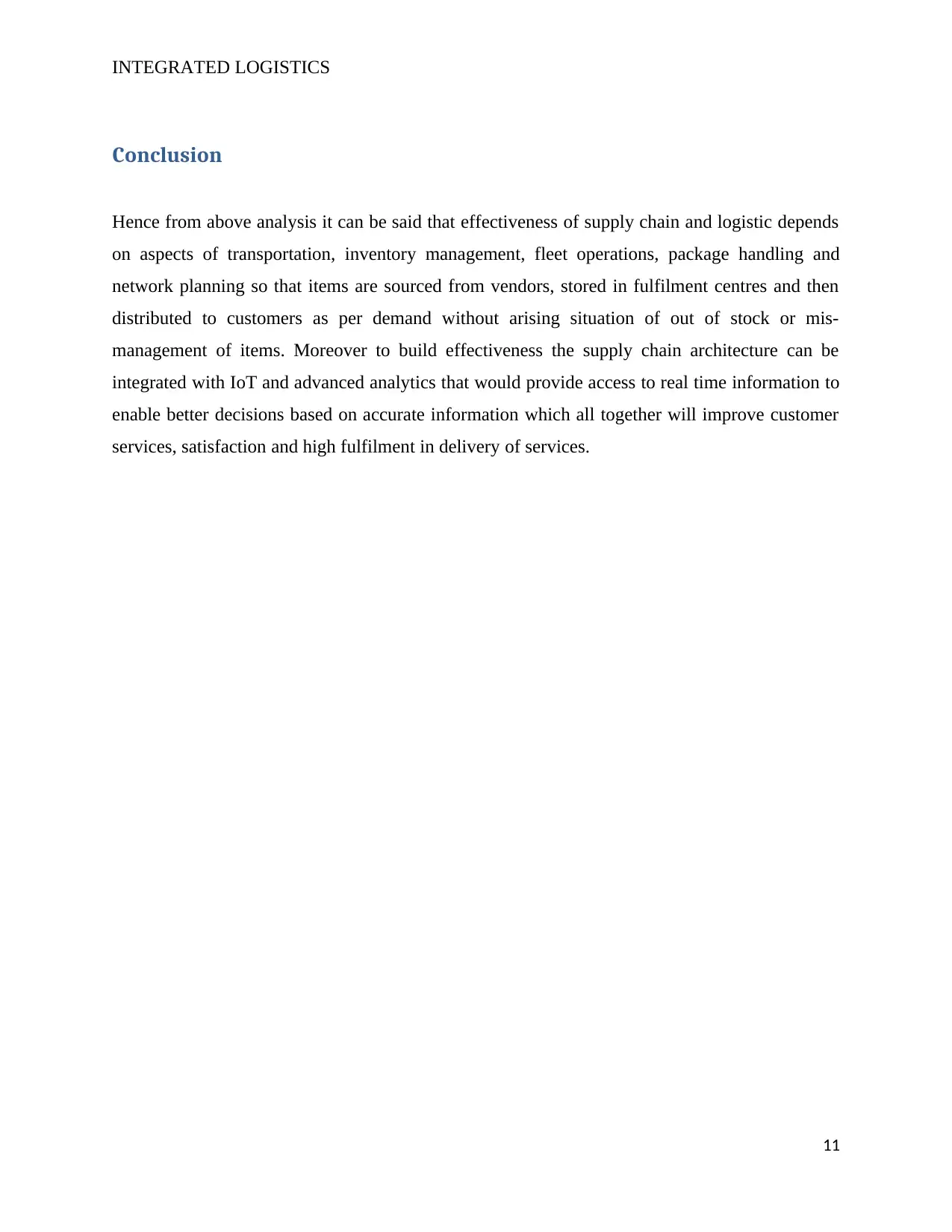
INTEGRATED LOGISTICS
Conclusion
Hence from above analysis it can be said that effectiveness of supply chain and logistic depends
on aspects of transportation, inventory management, fleet operations, package handling and
network planning so that items are sourced from vendors, stored in fulfilment centres and then
distributed to customers as per demand without arising situation of out of stock or mis-
management of items. Moreover to build effectiveness the supply chain architecture can be
integrated with IoT and advanced analytics that would provide access to real time information to
enable better decisions based on accurate information which all together will improve customer
services, satisfaction and high fulfilment in delivery of services.
11
Conclusion
Hence from above analysis it can be said that effectiveness of supply chain and logistic depends
on aspects of transportation, inventory management, fleet operations, package handling and
network planning so that items are sourced from vendors, stored in fulfilment centres and then
distributed to customers as per demand without arising situation of out of stock or mis-
management of items. Moreover to build effectiveness the supply chain architecture can be
integrated with IoT and advanced analytics that would provide access to real time information to
enable better decisions based on accurate information which all together will improve customer
services, satisfaction and high fulfilment in delivery of services.
11
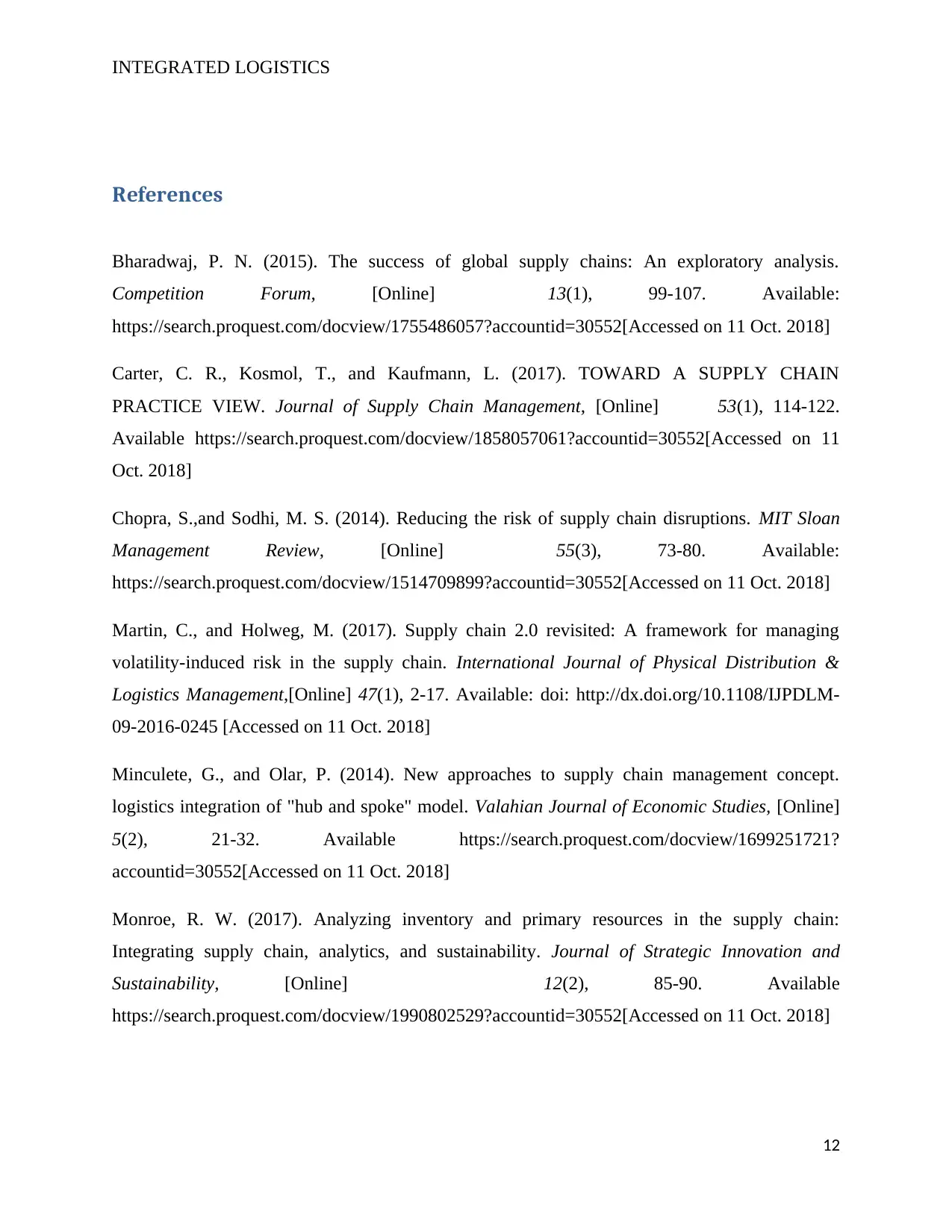
INTEGRATED LOGISTICS
References
Bharadwaj, P. N. (2015). The success of global supply chains: An exploratory analysis.
Competition Forum, [Online] 13(1), 99-107. Available:
https://search.proquest.com/docview/1755486057?accountid=30552[Accessed on 11 Oct. 2018]
Carter, C. R., Kosmol, T., and Kaufmann, L. (2017). TOWARD A SUPPLY CHAIN
PRACTICE VIEW. Journal of Supply Chain Management, [Online] 53(1), 114-122.
Available https://search.proquest.com/docview/1858057061?accountid=30552[Accessed on 11
Oct. 2018]
Chopra, S.,and Sodhi, M. S. (2014). Reducing the risk of supply chain disruptions. MIT Sloan
Management Review, [Online] 55(3), 73-80. Available:
https://search.proquest.com/docview/1514709899?accountid=30552[Accessed on 11 Oct. 2018]
Martin, C., and Holweg, M. (2017). Supply chain 2.0 revisited: A framework for managing
volatility-induced risk in the supply chain. International Journal of Physical Distribution &
Logistics Management,[Online] 47(1), 2-17. Available: doi: http://dx.doi.org/10.1108/IJPDLM-
09-2016-0245 [Accessed on 11 Oct. 2018]
Minculete, G., and Olar, P. (2014). New approaches to supply chain management concept.
logistics integration of "hub and spoke" model. Valahian Journal of Economic Studies, [Online]
5(2), 21-32. Available https://search.proquest.com/docview/1699251721?
accountid=30552[Accessed on 11 Oct. 2018]
Monroe, R. W. (2017). Analyzing inventory and primary resources in the supply chain:
Integrating supply chain, analytics, and sustainability. Journal of Strategic Innovation and
Sustainability, [Online] 12(2), 85-90. Available
https://search.proquest.com/docview/1990802529?accountid=30552[Accessed on 11 Oct. 2018]
12
References
Bharadwaj, P. N. (2015). The success of global supply chains: An exploratory analysis.
Competition Forum, [Online] 13(1), 99-107. Available:
https://search.proquest.com/docview/1755486057?accountid=30552[Accessed on 11 Oct. 2018]
Carter, C. R., Kosmol, T., and Kaufmann, L. (2017). TOWARD A SUPPLY CHAIN
PRACTICE VIEW. Journal of Supply Chain Management, [Online] 53(1), 114-122.
Available https://search.proquest.com/docview/1858057061?accountid=30552[Accessed on 11
Oct. 2018]
Chopra, S.,and Sodhi, M. S. (2014). Reducing the risk of supply chain disruptions. MIT Sloan
Management Review, [Online] 55(3), 73-80. Available:
https://search.proquest.com/docview/1514709899?accountid=30552[Accessed on 11 Oct. 2018]
Martin, C., and Holweg, M. (2017). Supply chain 2.0 revisited: A framework for managing
volatility-induced risk in the supply chain. International Journal of Physical Distribution &
Logistics Management,[Online] 47(1), 2-17. Available: doi: http://dx.doi.org/10.1108/IJPDLM-
09-2016-0245 [Accessed on 11 Oct. 2018]
Minculete, G., and Olar, P. (2014). New approaches to supply chain management concept.
logistics integration of "hub and spoke" model. Valahian Journal of Economic Studies, [Online]
5(2), 21-32. Available https://search.proquest.com/docview/1699251721?
accountid=30552[Accessed on 11 Oct. 2018]
Monroe, R. W. (2017). Analyzing inventory and primary resources in the supply chain:
Integrating supply chain, analytics, and sustainability. Journal of Strategic Innovation and
Sustainability, [Online] 12(2), 85-90. Available
https://search.proquest.com/docview/1990802529?accountid=30552[Accessed on 11 Oct. 2018]
12
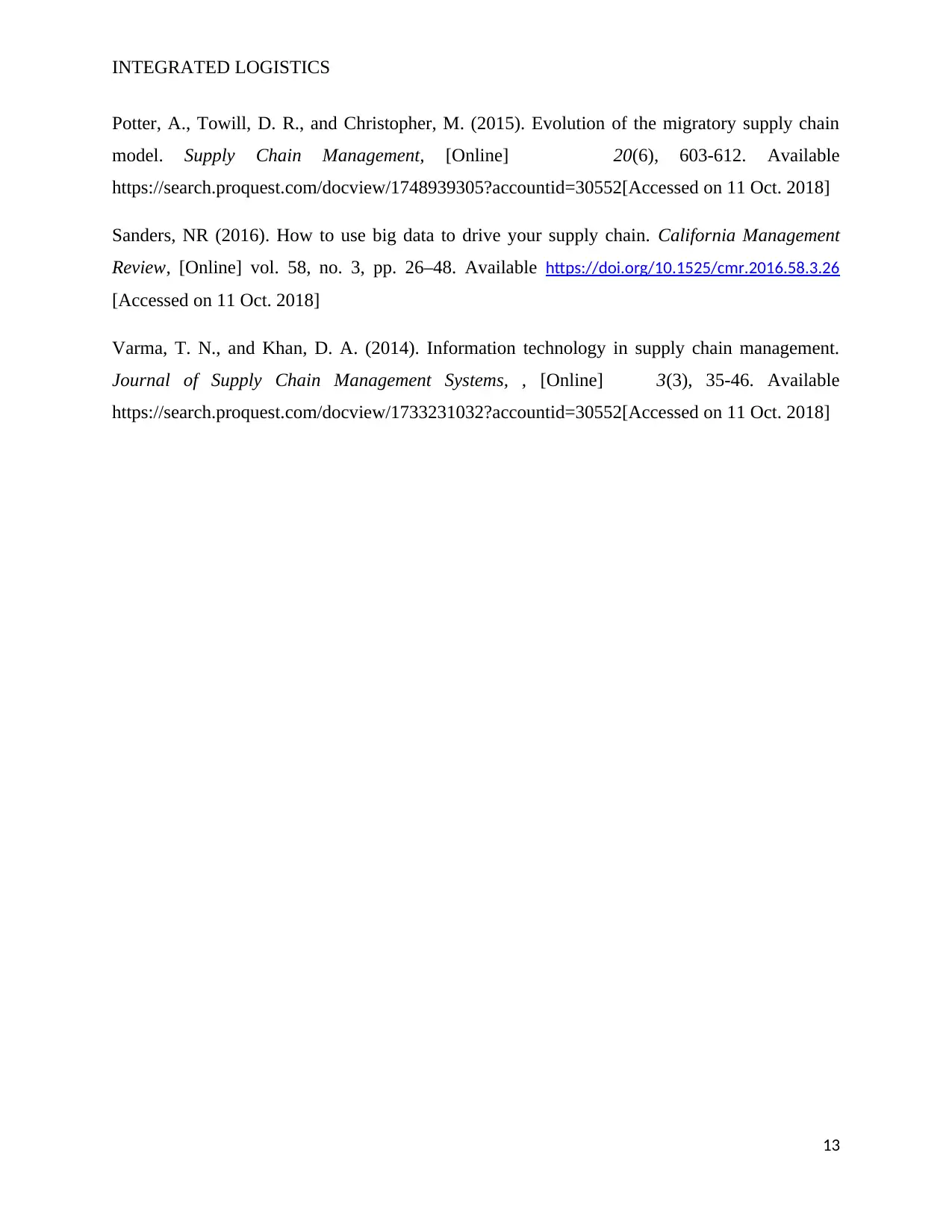
INTEGRATED LOGISTICS
Potter, A., Towill, D. R., and Christopher, M. (2015). Evolution of the migratory supply chain
model. Supply Chain Management, [Online] 20(6), 603-612. Available
https://search.proquest.com/docview/1748939305?accountid=30552[Accessed on 11 Oct. 2018]
Sanders, NR (2016). How to use big data to drive your supply chain. California Management
Review, [Online] vol. 58, no. 3, pp. 26–48. Available https://doi.org/10.1525/cmr.2016.58.3.26
[Accessed on 11 Oct. 2018]
Varma, T. N., and Khan, D. A. (2014). Information technology in supply chain management.
Journal of Supply Chain Management Systems, , [Online] 3(3), 35-46. Available
https://search.proquest.com/docview/1733231032?accountid=30552[Accessed on 11 Oct. 2018]
13
Potter, A., Towill, D. R., and Christopher, M. (2015). Evolution of the migratory supply chain
model. Supply Chain Management, [Online] 20(6), 603-612. Available
https://search.proquest.com/docview/1748939305?accountid=30552[Accessed on 11 Oct. 2018]
Sanders, NR (2016). How to use big data to drive your supply chain. California Management
Review, [Online] vol. 58, no. 3, pp. 26–48. Available https://doi.org/10.1525/cmr.2016.58.3.26
[Accessed on 11 Oct. 2018]
Varma, T. N., and Khan, D. A. (2014). Information technology in supply chain management.
Journal of Supply Chain Management Systems, , [Online] 3(3), 35-46. Available
https://search.proquest.com/docview/1733231032?accountid=30552[Accessed on 11 Oct. 2018]
13
1 out of 13
Related Documents
Your All-in-One AI-Powered Toolkit for Academic Success.
+13062052269
info@desklib.com
Available 24*7 on WhatsApp / Email
![[object Object]](/_next/static/media/star-bottom.7253800d.svg)
Unlock your academic potential
© 2024 | Zucol Services PVT LTD | All rights reserved.



